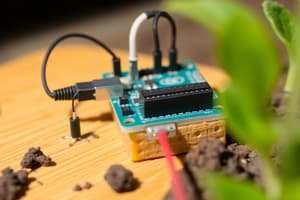Podcast
Questions and Answers
What function is used for initializing variables and pin modes when an Arduino program starts?
What function is used for initializing variables and pin modes when an Arduino program starts?
- void begin() { }
- void loop() { }
- void setup() { } (correct)
- void start() { }
Which command is used to read the value from a digital pin on the Arduino?
Which command is used to read the value from a digital pin on the Arduino?
- analogWrite(pin, value)
- analogRead(pin)
- digitalWrite(pin, value)
- digitalRead(pin) (correct)
What is the main role of the loop function in an Arduino program?
What is the main role of the loop function in an Arduino program?
- To execute the setup function repeatedly
- To define the pin modes of the Arduino
- To run code continuously after setup (correct)
- To initialize libraries and variables
How many digital input/output pins are available on the Arduino Uno?
How many digital input/output pins are available on the Arduino Uno?
What are breadboards used for in circuit design?
What are breadboards used for in circuit design?
What type of variable can be defined to store decimal numbers in Arduino programming?
What type of variable can be defined to store decimal numbers in Arduino programming?
Flashcards
Arduino IDE
Arduino IDE
Software used to write, compile, and upload code to Arduino boards.
Setup Function
Setup Function
A function that runs only once when the Arduino program starts, used for initializing variables and pin modes.
Loop Function
Loop Function
A function that runs continuously after the setup function, executing the main code repeatedly.
digitalWrite()
digitalWrite()
Signup and view all the flashcards
analogRead()
analogRead()
Signup and view all the flashcards
Breadboard
Breadboard
Signup and view all the flashcards
Study Notes
Arduino Uno
Basic Programming
-
Programming Environment:
- Use the Arduino Integrated Development Environment (IDE) for writing and uploading code.
- Supports C and C++ programming languages.
-
Basic Structure of a Program (Sketch):
-
Setup Function:
- Runs once when the program starts.
- Used for initializing variables, pin modes, and libraries.
- Syntax:
void setup() { /* code */ }
-
Loop Function:
- Runs continuously after the setup function.
- Used for executing the main code repeatedly.
- Syntax:
void loop() { /* code */ }
-
-
Basic Commands:
digitalWrite(pin, value): Sets pin HIGH or LOW.digitalRead(pin): Reads the value from a digital pin.analogRead(pin): Reads the value from an analog pin (0-1023).analogWrite(pin, value): Writes an analog value (PWM) to a pin.
-
Variables:
- Local and global variables can be defined for storing data.
- Common data types:
int,float,char,boolean.
-
Control Structures:
- Conditional Statements:
if,else if,elsefor decision-making. - Loops:
for,while, anddo whilefor repetitive tasks.
- Conditional Statements:
-
Libraries:
- Additional functionalities can be included using libraries (e.g.,
Servo,Wirefor I2C).
- Additional functionalities can be included using libraries (e.g.,
Circuit Design
-
Components:
- Microcontroller: ATmega328P (main chip on Arduino Uno).
- Digital Pins: 14 digital input/output pins (0-13).
- Analog Pins: 6 analog input pins (A0-A5).
- Power Pins: 5V, 3.3V, GND (ground), Vin (input voltage).
-
Breadboards:
- Used for assembling circuits without soldering.
- Easily connect and disconnect components.
-
Wiring:
- Use jumper wires for connections.
- Ensure correct GPIO pin mapping according to the design.
-
Basic Circuit Examples:
-
LED Circuit:
- Connect an LED with a resistor to a digital pin for control.
-
Button Circuit:
- Use a push button connected to a digital pin with a pull-down resistor.
-
-
Power Supply:
- Powered via USB or external battery (7-12V).
- Onboard regulator converts voltage for components.
-
Common Tools:
- Multimeter for measuring voltage, current, and resistance.
- Oscilloscope for analyzing the signal waveform (optional).
-
Simulation Software:
- Tools like Tinkercad can simulate circuits before physical implementation.
Arduino Uno Programming
- Arduino IDE: is used to write and upload code to the Arduino Uno
- Programming Language: Arduino IDE uses C and C++
- Code Structure:
- setup(): runs once, used for initializations
- loop(): runs repeatedly after setup(), main code execution
- Basic Commands:
- digitalWrite(pin, value): controls digital pins, sets HIGH or LOW state
- digitalRead(pin): reads the value from a digital pin
- analogRead(pin): reads values from analog pins (0-1023)
- analogWrite(pin, value): outputs an analog value (PWM)
- Variables:
- Local: defined within a function's scope
- Global: defined outside functions, accessible anywhere in the code
- Data Types:
int,float,char,booleanstore different data types
- Control Structures:
- Conditional statements:
if,else if,elsefor decision making - Loops:
for,while,do whilefor repetitive tasks
- Conditional statements:
- Libraries:
- Offer additional functionalities like
Servo,Wirefor I2C communication
- Offer additional functionalities like
Circuit Design
- Microcontroller: ATmega328P, the main chip on the Arduino Uno
- Digital Pins: 14 pins (0-13) that can be used for input or output
- Analog Pins: 6 pins (A0-A5) for analog input (0-1023)
- Power Pins:
- 5V: 5 volts supply for the Arduino
- 3.3V: 3.3 volts supply for some components
- GND: Ground connection
- Vin: External input voltage (7-12V)
- Breadboards:
- Used for prototyping circuits without soldering
- Provide a grid for easily connecting components
- Wiring:
- Use jumper wires to connect components
- Match GPIO pin numbers to the circuit design
- Circuit Examples:
- LED Circuit: Connect an LED with a resistor to a digital pin for control
- Button Circuit: Connect a push button to a digital pin with a pull-down resistor
- Power Supply:
- USB: Power the Arduino via a USB cable
- External Battery: Use a 7-12V external battery for power
- Onboard Regulator: Regulates the input voltage to 5V for internal components
- Tools:
- Multimeter: Measures voltage, current, and resistance
- Oscilloscope: Analyzes signal waveforms (optional)
- Simulation Software:
- Tinkercad: Simulate circuits virtually before physical implementation
Studying That Suits You
Use AI to generate personalized quizzes and flashcards to suit your learning preferences.




